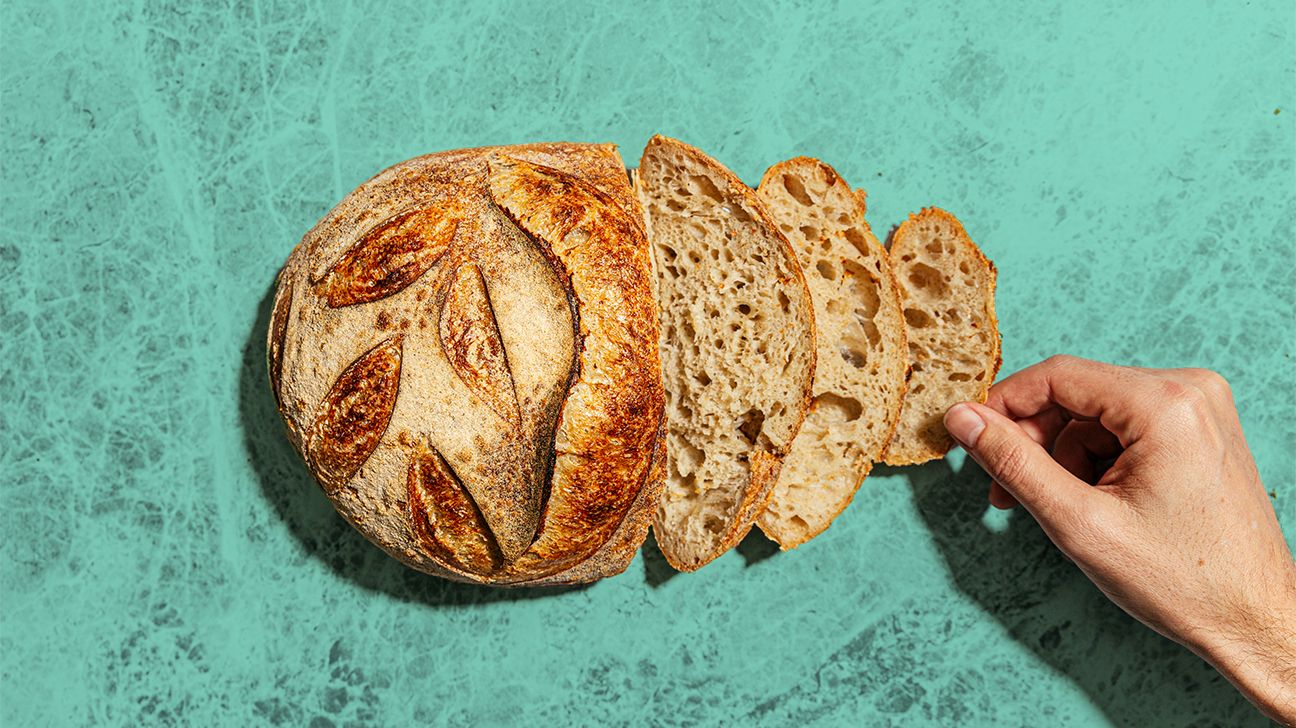Who hasn’t started (and failed and restarted) a stay-at-home hobby by now? Some try their hands at indoor gardening, others jewelry making or cross stitching — but there has been no star on a bigger rise than sourdough bread baking.
For many reasons, bread baking is an ideal stay-at-home activity. It keeps your hands and mind busy without a screen; it takes commitment and time (which most of us have a ton of right now); and most importantly, carbs! Carbs bring our bellies and minds much-needed comfort in this time of uncertainty.
With physical distancing comes avoiding grocery store trips at all costs, so baking with ingredients you already have on hand is ideal. And with yeast out of stock in most places, what makes sourdough bread unique is that you don’t need yeast.
Sourdough is made with a “starter” (aka the “mother”), which is a combo of flour and water (yay, kitchen staples!). Those two ingredients turn into a paste that’s becomes fermented by wild yeast and probiotic bacteria, which leavens the bread. This also gives sourdough its distinctly “sour” flavor.
You also have to “feed” your starter and discard some of it everyday, which, in a time of feeling denied of human interaction or connection, can become a really social event. You can make chips from your discard or split your excess starter into jars and give them to your loved ones (or neighbors). Leave it on their doorsteps so they can bake adorably named “friendship bread.”
So yes, sourdough is delicious. But the rewarding process is also a labor of love that gives you purpose, control, and busy hands while you’re stuck at home. It’s a win-win!
If you’re ready to jump on the sourdough bandwagon, first you need to alchemize a starter from scratch, which also requires about a week’s worth of tending to before you bake your bread. You have to feed it and care for it daily, which makes it expand, contract, and move. Having a starter is like having a pet in your kitchen, which is equal parts fun and fascinating. Some people even name them!
A well-nurtured starter makes for yummier sourdough. What’s even crazier is you can store the same starter in the refrigerator and use it for years. Some bakeries claim their starters are over 100 years old.
Ingredients and supplies
There are many different methods for creating and feeding a starter, but this recipe from Metro will get you there in six easy steps.
Directions
- Grab your clean jar and add equal amounts of flour and lukewarm water (start with about a cup of each); stir until well-blended. Make sure you leave space for your starter to grow big and strong!
- Leave the jar uncovered overnight and store somewhere warm (an ideal temperature is somewhere between 78–82°F or about 26°C, away from direct sunlight).
- The next day, discard half of the contents and “feed” your starter by adding 1/2 cup of flour and 1/2 cup of water (or, half of the original amount you started with). This is your “discard,” which you can also save in a separate jar and bake certain things with it.
- Repeat this discard-and-feed process once a day, every day, until you see bubbles in your mixture; this will happen in about 5 to 7 days.
- Once you see bubbles and notice that your starter smells yeasty, it’s active. Another way to check to see if it’s ready for baking, scoop out a small spoonful of starter and put it into a cup of water — if it floats, it’s time to bake some bread!
- Store in the refrigerator and feed it once a week to keep your starter healthy. Bring it to room temperature first, add equal amounts of flour and water, then leave it out for a half hour before refrigerating again.
Sourdough bread is just the beginning! From pancakes to pasta, this roundup of recipes will inspire you to expand your sourdough horizons and get tons of mileage out of your starter and discard.
- Flaky, buttery, sourdough biscuits baked to golden perfection — need we say more? The combo of scallions and sour cream really give these guys their flavor.
- Sourdough bagels are extra fun to make — not only do you get to use your finger to poke a hole in a ball of dough and shape it into a bagel, but then you get to boil ’em and watch ’em take shape and float to the top. Before baking, sprinkle with some poppy or sesame seeds.
- Using only a few cupboard staples and your starter, up your breakfast game with sourdough pancakes. They have extra fluff factor and prep work takes less than 10 minutes.
- Mix your starter with two eggs and flour, and make sourdough pasta! Let your ball of dough sit overnight, roll it out super-thin, then cut it into any pasta shape you want — if you cut thick strips/noodles, you can stuff with cheese and make ravioli.
- Using your starter discard, jazz up taco Tuesday with sourdough tortillas — they’re arguably softer and more flavorful than regular old flour tortillas. If you make a big batch, you can slice some tortillas into triangles, drizzle with olive oil, and bake an extra 5 minutes for tortilla chips.
- Finally carb’d-out? Whip up some soft, chewy sourdough granola bars. You’ll need a few more extra ingredients for this one (like quinoa, oats, dried fruit, walnuts, and chocolate chips), but you’ll thank yourself later for having a homemade healthy snack on hand.
Brooke Sager is a freelance writer who shares her musings on wine, wellness, beauty, relationships, and all things lifestyle.

